Monthly Archives: November 2019
Storage Share, Nov. 21/22, 2019
- On: November 20, 2019
 0
0
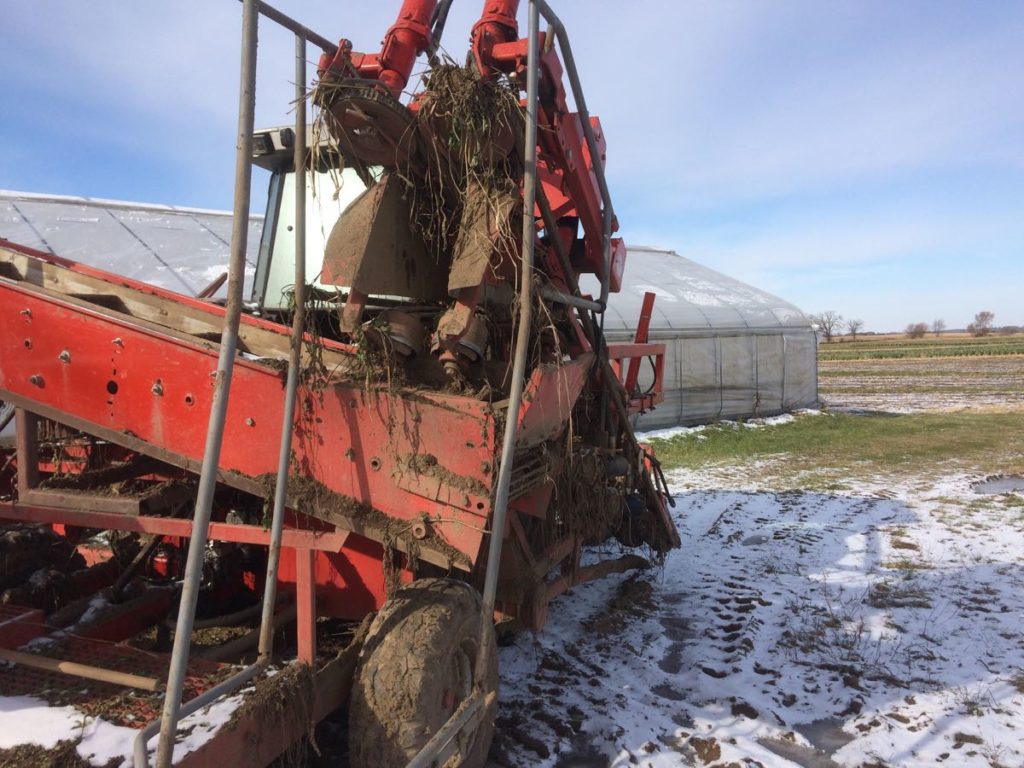
We ended the season with all our equipment covered in mud, including this very muddy carrot harvester.
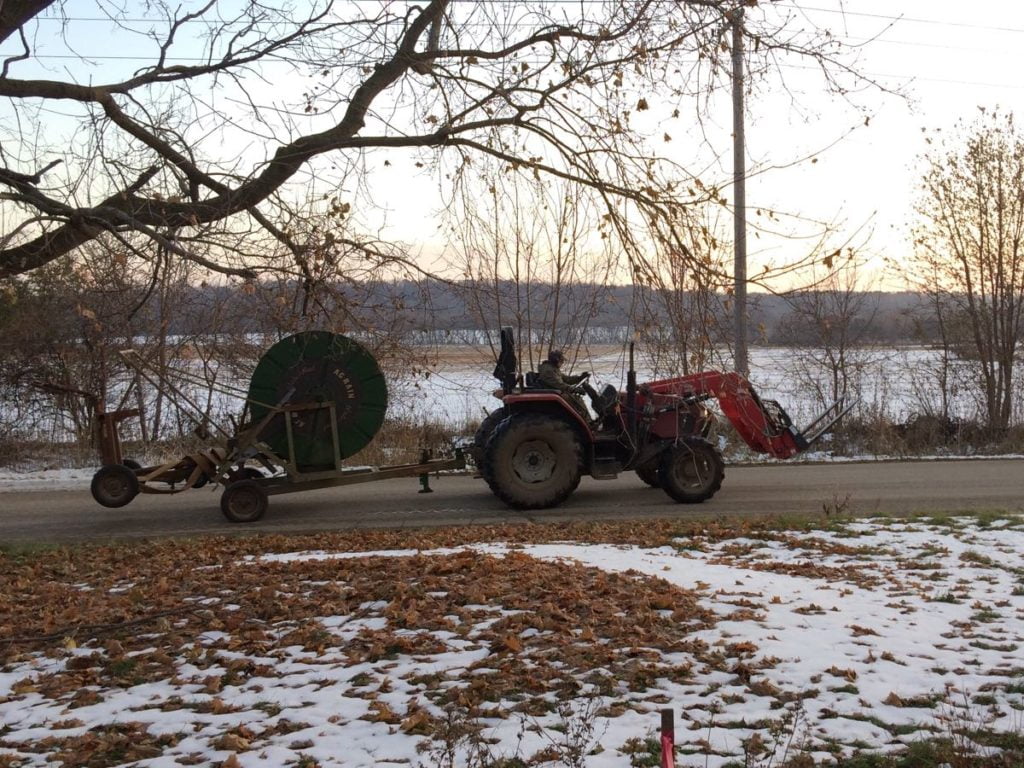
Steve takes our irrigator to overwinter in the neighbor’s shed. It didn’t get much use this year.
Our season is DONE. Often, we’re still harvesting in November but the cold weather ended our outdoor work. We are very grateful for the recent warm-up. It makes everything easier, including getting this Storage Share ready. The warmer weather has given us a chance to clean equipment before putting it away in storage until spring. We worried that we’d have to put everything away covered in mud.
Now we look forward to winter, with lots of cooking, ice skating and skiing (we hope!) before planning next season. Have a wonderful Thanksgiving! Beth & Steve
Storage Share this week
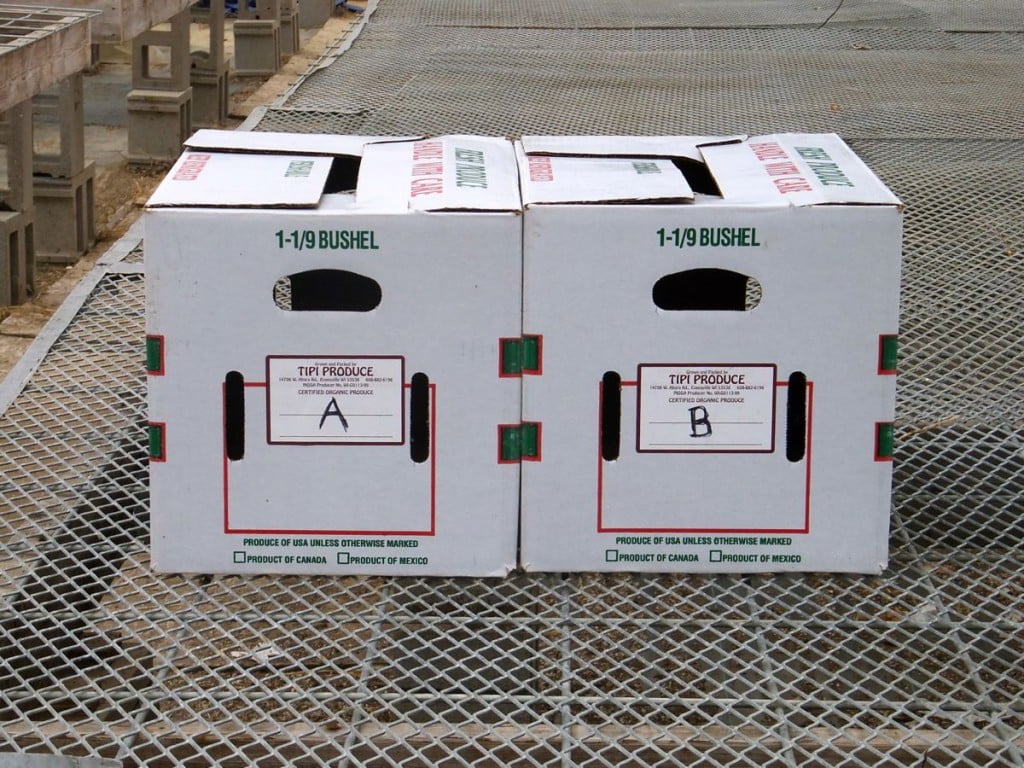
Take one box labelled “A” and one box labelled “B”.
Things you need to know about your winter share
* Your delivery will consist of two different boxes, labeled “A” and “B”. Take one “A” box and one “B” box. The boxes contain different vegetables.
* Please pick up your boxes on the day of delivery, during the normal hours for your site.
* Outpost members, pick up your boxes on Friday. This is the busiest weekend of the year for the Outpost staff, so they WILL NOT hold boxes past Friday, nor can they handle special requests.
* Members at unheated sites, please replace the blankets carefully. That keeps everyone’s produce in good shape.
* Bring lots of bags to take your produce home. It’s a lot of produce!
Veggie List and Storage Info (Storage share, Nov. 21/22, 2019)
We hope you enjoy this shipment of veggies. Strategize to use them well, as some will last longer than others.
* These are the most perishable vegetables: kale, the green parts of the leeks
* These are the next-most perishable: Brussels sprouts, cabbage, the white parts of the leeks, and onions. Keep an eye on your butternut, potatoes and sweet potatoes. The last two are susceptible to drying out. Expect the largest butternuts to last the longest.
* These will last the longest: daikon radish, beets, carrots, celeriac, garlic, parsnips.
Box “A”
Refrigerate everything in this box.
Beets, 3 lb
Brussels sprouts, on stalks
Carrots, 6 lb total
….. orange ~4 lb
….. yellow & purple ~2 lb
Celeriac, 1
Daikon winter radishes, several
Green cabbage, 1 medium or 2 small
Kale “garnish”
Leeks, ~3 lb
Parsnips, ~3 lb
Box “B”
The Brussels sprouts need refrigeration. Everything else in this box can be stored cool or at room temperature. See notes below for more detail.
One more Brussels sprouts stalk
Butternut squash, 9 – 10 lb
Garlic, 3 bulbs
Onions, 5 lb total
….. ~1 lb red
….. ~4 lb yellow
Potatoes, russet, 5 lb
Potatoes, Satina, 5 lb
Shallots, 2
Sweet potatoes, ~10 lb
Beets – Refrigerate in a bag or container. Beets will store for two months or longer.
Brussels sprouts – Pluck from stalks and refrigerate in a bag or container. Do this the day you pick up your CSA boxes. Eat within 2 to 3 weeks.
Butternut winter squash – You will receive ~9 lbs of squash. Store your butternut in a cool, dry place. 60 F is ideal. Do not put in a plastic bag. Expect the largest butternuts to store the longest. Inspect your squash frequently and cook promptly if you see any soft spots developing. You can cook, mash and freeze the squash for future use. I find that you can refrigerate cut raw squash for up to one week. This runs counter to the accepted way to store squash, but is useful if you want to cook just half a squash. Try microwaving your squash for one to two minutes before cutting or peeling. This softens the squash and makes a large butternut easier to handle.
Cabbage – Refrigerate.
Carrots, orange. Refrigerate in a plastic bag. Will keep for several weeks.
Carrots, yellow & purple. These varieties are pretty AND they taste good.
Celeriac – Will store for months in your fridge. Cut off chunks as needed. Peel before using. I find it easiest to cut the celeriac into flat slices, then peel.
Daikon radishes (oblong, white or purple) – Refrigerate. The interior color of the purple ones is lovely. Slice thinly and add to salads, cook lightly in mixed vegetable medleys or cut into matchsticks and add to pasta salads. We enjoy grated carrot and daikon salads all winter.
Garlic – Store at room temperature.
Kale – It is tiny. We rarely send something so small. However, that was the last thing our crew harvested on a cold, dim, muddy day. They were so proud of what they accomplished that now we have to use it. Tuck it in a dish or use it as a garnish. The crew brainstormed and they think it would make a great corsage for the Thanksgiving cook in your household. Storage: Refrigerate and use soon.
Leeks. The bottoms (white part) will store longer than the tops (green and pale-green parts). We suggest that you cut off and use the tops first. It’s unconventional but you’ll be able to store the bottoms for longer. In general, leeks are not a long-storage crop. You may need to strip off one or two outer leaves to freshen the leeks before you cook them.
Onions: Refrigerate or store in a cool, dark spot and protect from light. Exposure to light stimulates sprouting. If you have the room, it’s safer to store the onions in the refrigerator. After the wet fall, they might not last as long as usual.
Parsnips (These look like large white carrots.) – Refrigerate in a plastic bag. Parsnips will store for several months but will darken in color. That is a harmless change.
Potatoes; russets and Satinas – Can be stored at room temperature or in a cool spot, but must be kept in the dark so they do not turn green. A cloth or loose plastic bag draped over the paper bag will slow moisture loss, but do not close the plastic bag. Both types will store longer if kept cool. Around 40 – 50 F is ideal. The potatoes were grown by the Igl family near Antigo.
Russets– We got the big ‘baking’ grade so you have nice bakers for Thanksgiving. Excellent for baked or mashed potatoes.
Satinas– These are good all-purpose potatoes, everything from roasted to potato salad. I really like this variety of yellow potato because they oven-roast so well and because they are less sweet than other yellow varieties such as Yukon Golds.
Shallots (look like small red onions) – Good for salad dressing.
Sweet potatoes – These are the Covington variety, with excellent flavor and sweetness. Store at room temperature, no lower than 55 F, but 60+ F is better. Keep them on your kitchen counter where it’s easy to keep an eye on them. I like to keep ours in a paper bag so they don’t dehydrate. Cook promptly if they start to soften. The roots come in a wide ranges of sizes and all are good.
Recipe Ideas
I will not try to sway your Thanksgiving menus. I bet you have your dishes chosen, perhaps based on family tradition. However, this is a great time of year to gather recipes to enjoy all winter. You should peruse online cooking sites while they are feature Thanksgiving menus, many of which are suited to your Storage share vegetables. Bookmark the recipes soon; Thanksgiving collections are taken down quickly after the holiday. I have a huge list of recipes bookmarked to delve into this winter.
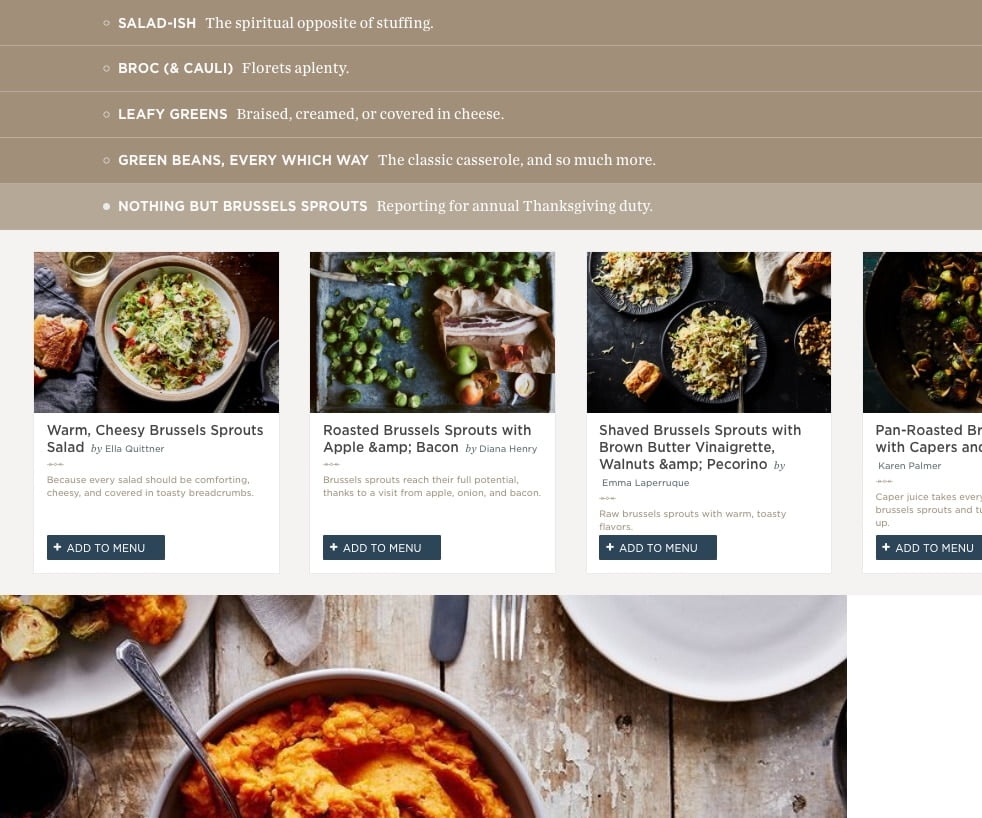
One small corner of Food52’s Thanksgiving Menu Maker.
♦ Once again, the lively Food52.com site has outdone itself with a fantastic Thanksgiving recipe collection. They call it their “AutoMagic Thanksgiving Menu Maker“. It’s organized by type of dish, e.g.
. “Gratins; Lots of creamy layers,” and
. “Veggie Packed Stuffing; Bring on the fall bounty”, and
. “Nothing but Brussels sprouts; Reporting for Thanksgiving Duty.”
Section #6 (“Orange Sides”) is extensive. I’m gathering a suite of recipes to try this winter. First stop will be “The Absolute Best—& Worst—Way to Make Mashed Potatoes, According to So Many Tests.” The tag line is “I spent 14 hours alone with only potatoes, and I did it for you.” Yes, they are amusing.
♦ Smitten Kitchen is our go-to site for dessert recipes but has excellent veggie recipes too. You can follow her Thanksgiving preparations or go straight to an amazing list of Thanksgiving recipes from previous years. I’m itching to try her Roasted Cabbage with Walnuts and Parmesan recipe.
♦ The Dishing Up the Dirt site doesn’t have a specific Thanksgiving section, but many of her recipes are tailored to Storage share produce.
♦ Halfbaked Harvest has appealing dinner and salad ideas, and gorgeous food photos.
♦ Finally, remember that we can use Local Thyme recipes all winter. Check them out for Thanksgiving ideas.
Extension Share, Nov. 7/8, 2019
- On: November 06, 2019
 0
0
Extension Share
This is a stand-alone share, for those who registered. Our regular CSA season ended last week.
Mad dash
Folks, this is insane weather. Take a look at the forecast. Monday night is projected to be 8 degrees, followed by a string of nights almost as cold. We had no choice; in the last 10 days, we have sprinted through a month of harvests. It looked like Tuesday would be our last possible harvest. The day ended with almost all crops gathered except a field of parsnips still in the ground. That tainted our relief at getting almost everything finished. Then we got a reprieve! This morning’s snow skipped us, so Steve, Maggie and a few others got the harvester out and dug the parsnips. It was cold and windy but had to be done. The tractor and harvester ended the day completely covered in mud. Hopefully there will be a warm day to clean them before storing for winter.
Our field work is done. We are tired and our crew is tired, but we are thrilled to grub our way to the end of the field season. Thank you for being Tipi members this year! Beth & Steve
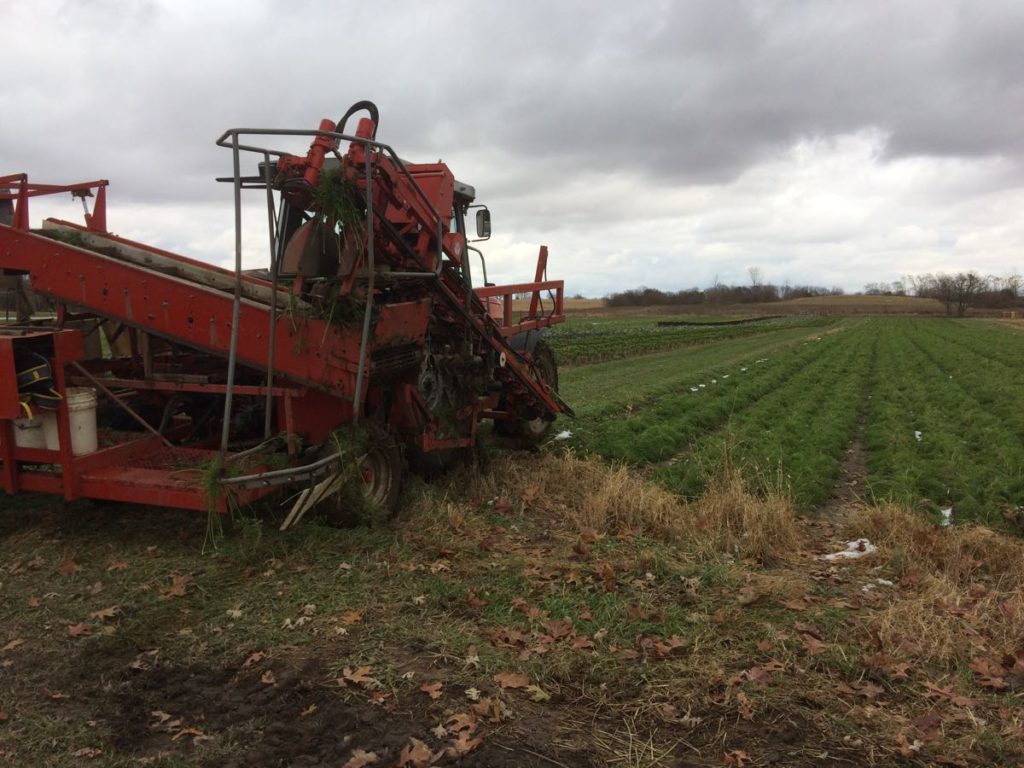
Weekend warriors. Steve and I spent the entire weekend harvesting carrots. Do you see the patches of snow between the carrot rows? We could not waste the weekend days.
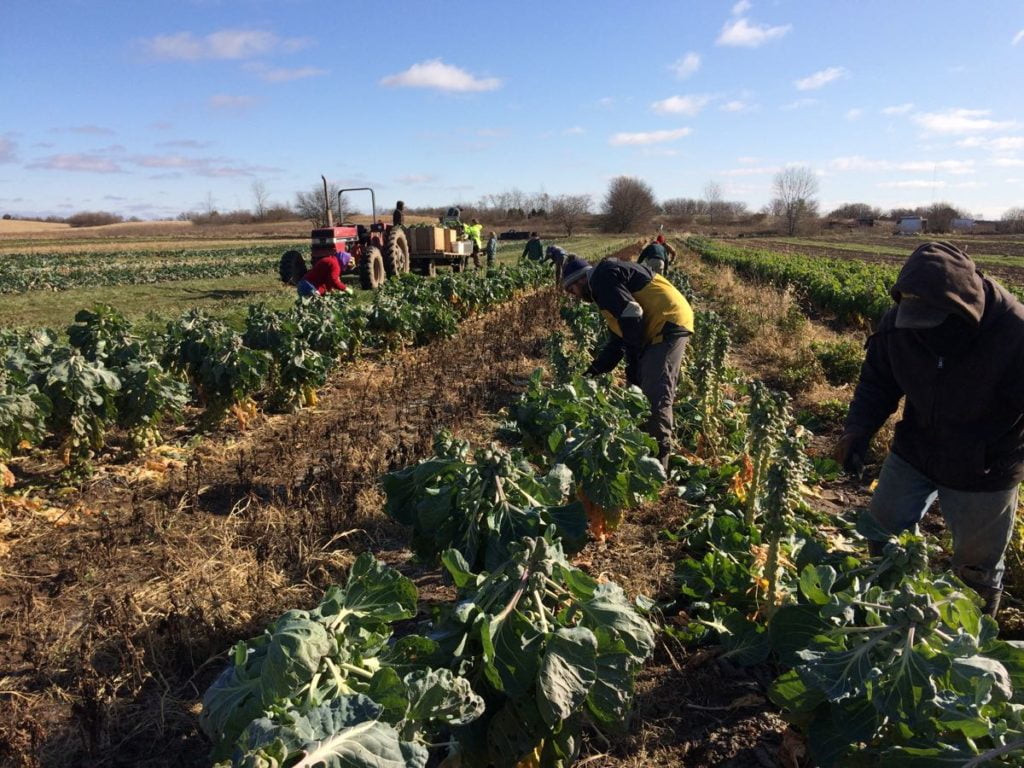
Only the most cold-hardy crops were still in the field on Tuesday. We made a mad dash through the Brussels sprouts field, cutting and piling stalks into bins. We worked indoors today to pluck the sprouts from the stalks.
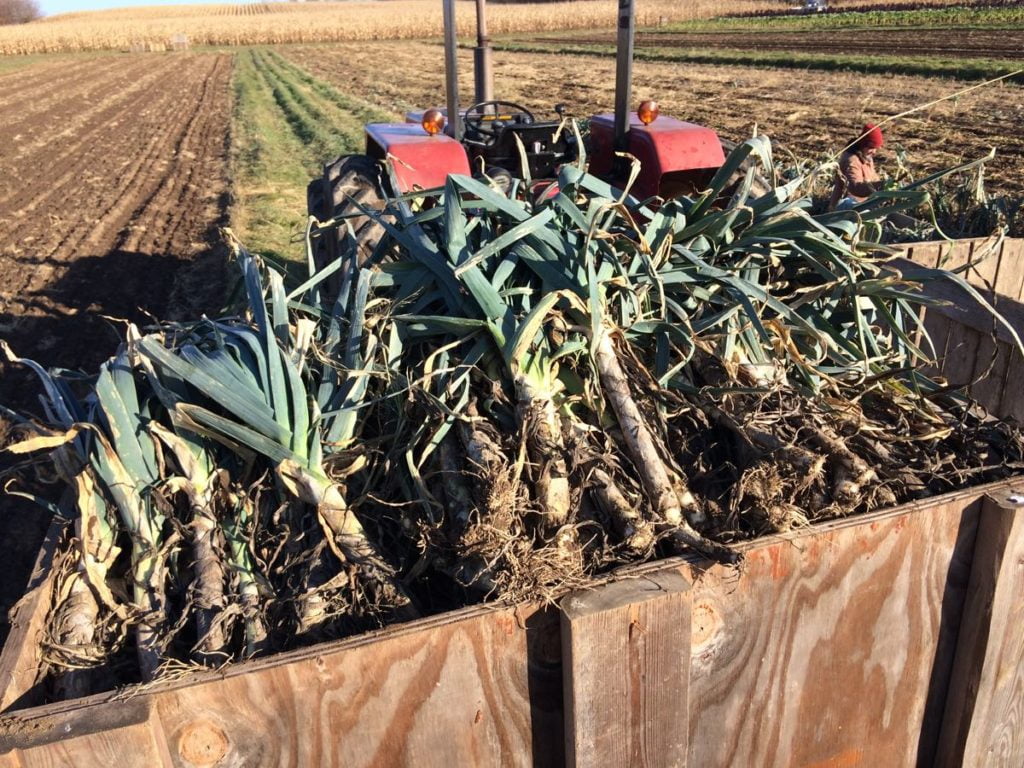
We filled bins with leeks too, then brought them back to the buildings to clean up.
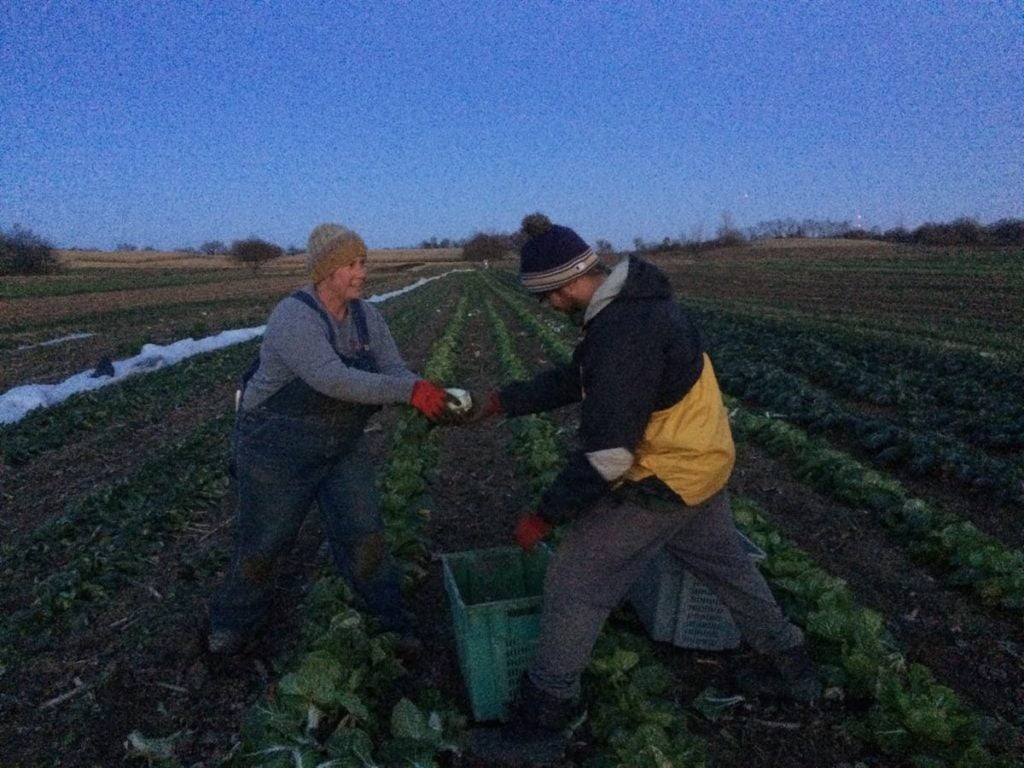
At dusk, Maggie and John raced to harvest the last napa cabbage.
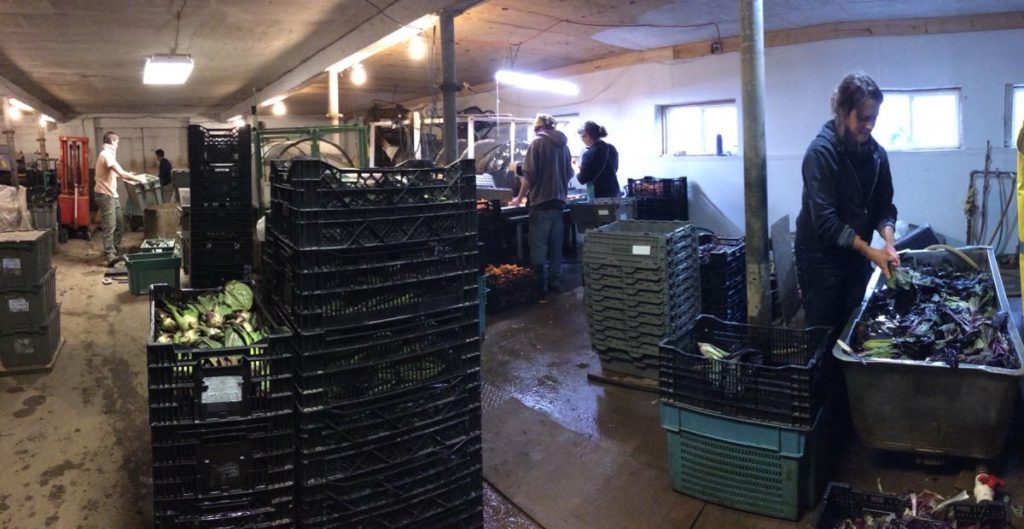
Today, we squeezed into our indoor heated space to prepare this week’s produce. It’s much smaller than our unheated pack shed and felt pretty crowded. From left, Billy and Jory prepare leeks, Smitty and Kristin wash carrots, and Karen washed bok choy.
Extension Share Veggie List
Red cabbage
Mixed fall greens, probably
– red bok choy, plus
– red mizuna, plus
– tatsoi.
‘Metro’ butternut squash
Sweet potatoes, ~3 lb
Brussels sprouts, ~ 1 lb
Carrots, 2 lb
Leeks, 1 – 1.25 lb
Yellow onion
A few items need extra washing.
The cold weather forced us into smaller quarters indoors. Your butternut squash, leeks and sweet potatoes are more lightly washed than usual, and will need a little extra attention from you. It’s the best we could do!
Mixed fall greens – We’re sending several small heads in the choy family. They’ll be good mixed together. The tat soi and the red choy have some silvering on the leaves, from being protected under row cover on cold nights.
RECIPES
Visit our 2019 Recipe Log or our 2018 Recipe Log or join our Facebook discussion group.
LOCAL THYME/ Comforting Classics
Brussels Sprouts with Lemon and Almonds
Red Cabbage and Brussels Sprout Slaw with Honey Poppy Seed Dressing
Black Eyed Peas and Greens Soup
Beef, Leek and Sweet Potato All-Day Stew
LOCAL THYME/ Outside the Box Recipes
Glass Noodles with Shredded Veggies and Sweet Chili Sauce
Braised Red Cabbage With Apples, Bacon and Wine
Miso Braised Chicken with Sweet Potato and Greens
Black Bean Burrito with Chipotle Sweet Potatoes and Red Cabbage
LOCAL THYME/ Quick & Easy Meal
Smoked Trout Salad on a Bed of Shredded Cabbage
????????????
RECIPES FROM LAUREN
BRUSSELS SPROUTS, PICKLED CARROTS & WINTER GREENS
Adapted from Six Seasons
Serves 2-4
Takes 1 hour
1 pound carrots, cut very thin on the diagonal
1 cup apple cider vinegar
1/2 cup water
1/2 cup sugar
2 tablespoons + 1 teaspoon Kosher salt, divided
1 tablespoon black peppercorns
1 tablespoon mustard seed
1 pound Brussels sprouts
1/4 cup olive oil, plus more for drizzling
1/4 teaspoon freshly ground black pepper
1/2 yellow onion, thinly sliced
1/4 cup honey
1/3 cup champagne vinegar
Pinch red pepper flakes
2 garlic cloves, minced
3 tablespoons butter
1 head mizuna, thinly sliced
1 head tatsoi, greens onion, thinly sliced
1 cup toasted walnuts, roughly chopped
- Preheat oven to 450 degrees.
- Place carrots in a small glass bowl.
- In a medium saucepan, combine vinegar, water, sugar, 2 tablespoons salt, peppercorns and mustard seed. Bring to a boil and then pour immediately over carrots. Set aside to quick pickle while you prepare the rest of the dish.
- Toss Brussels sprouts with olive oil, 1 teaspoon salt and pepper. Roast for 20-25 minutes until crisp all over. Place in large bowl with yellow onion.
- Meanwhile, heat honey in a small saucepan over medium low heat until it turns golden. Remove from heat and whisk in vinegar, red pepper flakes and garlic until smooth. Return to medium low heat and add butter, 1 tablespoon at a time, whisking until it melts. Let simmer 2-3 minutes more, stirring occasionally. Pour over Brussels and onions while still warm.
- Just before serving toss roasted veggies with greens, walnuts and half of the pickled carrots (store the rest in your fridge for up to 3 weeks). If the salad is too acidic, add a drizzle or two of olive oil.
.
????????????
.
FALL HARVEST RISOTTO
Takes 1 hour
Serves 6-8
4 tablespoons butter
2 large leeks, white and light green parts only, sliced in half lengthwise and sliced
1/2 large yellow onion, diced
2 cups peeled sweet potatoes, diced
3 cups butternut squash, peeled and diced
1 cup arborio rice
1/4 cup white wine
6 cups chicken broth
1/2 teaspoon dried sage
Kosher salt & freshly ground black pepper
- Melt butter in a large stockpot over medium heat. Add leeks and onions, along with a couple pinches of salt and pepper. Cook for 10 minutes.
- Reduce heat to medium low. Add potatoes, butternut squash and a few more pinches of salt and pepper. Cook for 15 minutes until soft, stirring every couple minutes. The bottom of the pan may brown a little, but don’t worry about this. It will just add flavor!
- In a separate large sauce pan, bring broth to a low simmer.
- Add rice and stir to combine. Stir for a couple minutes to toast the rice. Add wine and use a wooden spoon to scrape any browned bits off the bottom of the pan.
- Use a ladle to add a couple spoonfuls of simmering broth to the stockpot. Stir to combine and continue stirring every minute or so to keep it from sticking to the bottom of the pan. The idea is to stir it often enough that it has no chance to stick, but not so frequently that it doesn’t have a chance to simmer. Add sage after first addition of broth. Continue adding ladlefuls of stock every few minutes. You will keep adding and stirring and adding and stirring (slowly) for 30-35 minutes. Taste occasionally to test the texture of the rice. You want it to be cooked but not too mushy at the end. Adjust seasonings as desired.



